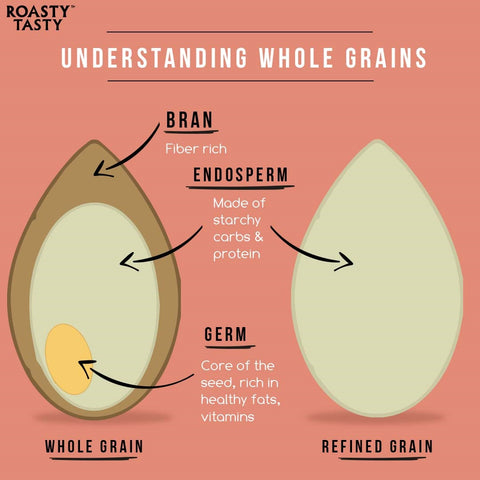Understanding Whole Grains
Understanding “Whole Grains”
The term "whole grains" strike a familiar though distant note in one’s mind. When one hears whole grain, they know it pertains to wellness, food and healthy eating but are not exactly sure about the meaning.
Whole grain refers to unrefined edible grain kernels that contain all three parts: the bran, germ and endosperm.
Bran: Bran is the outermost portion of the grain that surrounds the endosperm.
It may be removed from grains, along with the germ, to increase the shelf life of those products. 15% of wheat consists of bran.
Role in plant science: Being the harder outer shell, bran protects and nourishes the next generation of the plant from various circumstances such as rough weather etc.
What does it do for us: Bran is rich in insoluble fiber which aids digestion.
Endosperm: It is the starchy, energy source of the seed, from which the plant obtains nutrients for growth. It also contains proteins, some vitamins and minerals.
When a whole grain is processed to remove its bran and germ, what remains is the endosperm which makes it the refined grain.
What does it do for us: It provides energy in the form of carbs.
Germ: Germ is the embryo of the seed, where growth takes place. It forms 2 to 4% of the grain, depending on the species.
What does it do for us: It is rich in healthy fats, proteins and vitamin B.
How to know whether your snack is made from whole grains ✔️
1) Check for the industry sponsored “Whole Grain” Stamp (not very prevalent in India though)
2) Refer to the ingredient’s declaration on the back panel of the food label. Indian and global labelling rules demand that the ingredients be declared in descending order of percentage present in the snack. If your whole grain is a dominating ingredient in the snack, it will be one of the first few to be mentioned.
3) One study [4] mentions about the carbohydrate – to – fiber ratio acting as an indication of snacks containing whole grains. In this case, one will have to first crosscheck the ingredients of the snack (whether they contain any whole grains), and then refer to the numbers in the nutrition table for calculating the given ratio.
The ratio should be less than 10:1.

References:
[1] hsph.harvard.edu/nutritionsource/what-should-you-eat/whole-grains/
[2] https://wholegrainscouncil.org/what-whole-grain
[3] https://themillet.org/a-brief-history-of-millets/
[4] https://pubmed.ncbi.nlm.nih.gov/23286205/
Disclaimer: The contents of blog are for awareness purposes only and are not intended to offer personal medical advice. Please seek the advice of a certified medical practitioner for any questions on medical conditions.



